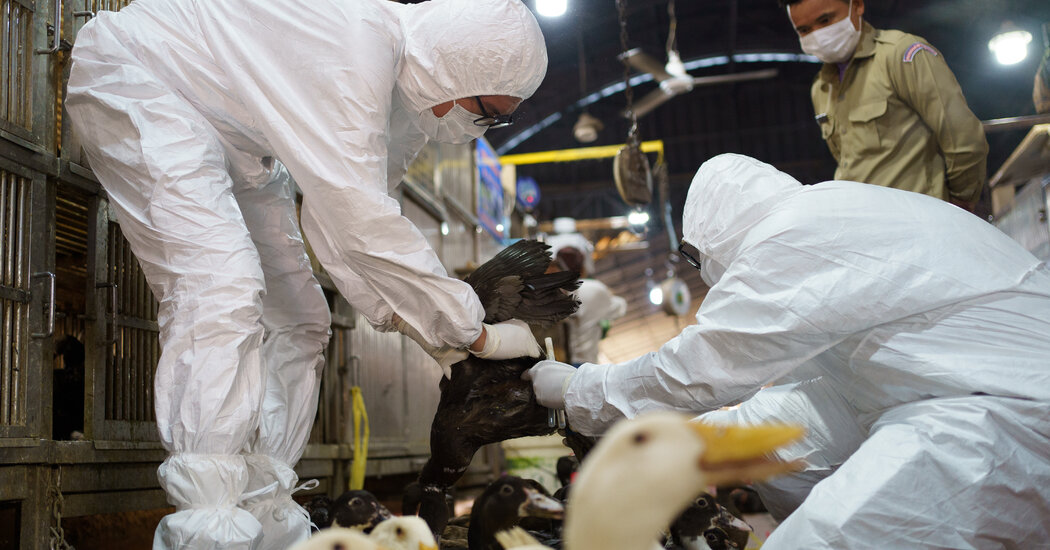Times Insider explains who we are and what we do and delivers behind-the-scenes insights into how our journalism comes together.
Many of the scientists Apoorva Mandavilli spoke to seemed convinced of the same thing: The bird flu virus, called H5N1, could cause the world’s next pandemic.
That was in 2002. And though H5N1, which first surfaced in 1996, did not immediately become as widespread as once feared, it never went away. Since 2003, H5N1 has infected nearly 900 people around the world, about half of whom died of their illness.
In the two decades since she began covering bird flu, Ms. Mandavilli, a science and global health reporter for The New York Times, has reported on a number of infectious diseases, such as Covid-19 and mpox, previously known as monkeypox, as well as scourges like H.I.V., tuberculosis and malaria.
Recently, she’s turned her attention back to H5N1, which is rapidly gaining new hosts, having made the leap from birds to various mammals, including dairy cows. According to public health authorities, three farmworkers in the United States, all of whom worked with dairy cows, became infected this spring with mostly mild symptoms.
In an interview, Ms. Mandavilli shared how the Covid pandemic has changed the way she covers viruses, including H5N1, and what we need to know about the current bird flu outbreak. This interview has been edited and condensed.
How does H5N1 compare with other viruses or infectious diseases you’ve reported on over your career?
It’s a bit of a slower burn, and you don’t know where it’s going quite yet. With Covid, we were thrust into the middle of a big crisis. Things like measles or H.I.V. are ongoing. And H5N1 has been around for quite a while. I started reporting on it in 2002. It’s sort of been a distant threat: “Maybe it’ll happen.”
This particular clade — or family of viruses — started in 2020. It was killing all these different birds and poultry. Since then, we’ve seen it in all kinds of mammals: foxes, raccoons, bears, mice, goats, sea lions, mink. It’s not the kind of thing that everyone needs to start panicking about, but knowing the potential for what this virus can do, it’s also not something we can ignore.
How, if at all, did the coronavirus pandemic, and your coverage of it, change how you approach reporting on viruses?
Covid influenced everything. If you’d asked me before Covid if the world was prepared for a pandemic, I would have said, “Parts of the world are prepared, and parts are not.” And I would have included the United States and Britain in the parts that were prepared. Then we saw what happened. Now, I’m aware of all the blind spots and all the things that can go wrong. When there’s an outbreak — and this happened with mpox, too — immediately, I’m laser-focused on, ‘What are they doing about this?’
Can you elaborate on what some of those things are?
One is vaccine development. Do we have a vaccine ready to go? Obviously with Covid, we didn’t, but with mpox, we did. But there were all these production issues with it. There was confusion at every level. Another is interagency communication. The current outbreak in dairy cattle requires three agencies to work together. The U.S.D.A., the C.D.C., the F.D.A. are all involved. And they don’t talk to one another well, which may be the case with any zoonotic outbreak. The F.D.A. regulates milk and milk products. And the C.D.C. worries about human infections.
In this outbreak, the C.D.C. is doing OK. But the U.S.D.A., which oversees farms, livestock and meat products, seems to be confused. I don’t think they are used to this level of attention, this level of scrutiny.
Why is it so important to shed light on the lack of communication between agencies?
It matters in terms of policy. If the right lawmakers pay attention, it could change things. It could make all the difference between this blowing up and it staying contained. We saw that with mpox.
It especially matters to the people who are affected. The ones who are most at risk are farmworkers. We should talk about how we can protect them. Right now, the farms are not testing people actively. They’re not testing cows actively. Nothing is mandatory; it’s all voluntary.
How do you balance the need for direct and accurate reporting with a responsibility not to spread unnecessary fear?
We always think about the readers. What do they need to know?
This is something that people should know about. But at the same time, you don’t want them to panic. One way I’ve done it is to quote some expert saying: “This is something I need to worry about and all the people I talk to have to worry about, but not necessarily something you need to worry about.”
Based on your reporting, how worried do you think the public should be about H5N1?
There are all these things we don’t know. H5N1 infections have not always been mild. The virus is changing and we don’t know exactly how or when it might be able to spread among people. Every expert I know is wary. The profusion of hosts has made a lot of my sources very nervous. It’s most adaptive to birds, but it’s shown itself capable of infecting a wide range of animals, which is unusual. We’ve now seen mammal-to-mammal transmission. It probably is capable at some point of getting to human-to-human transmission. We just don’t know if or when it will get there.
#Times #Covering #Bird #Flu #Outbreak,
#Times #Covering #Bird #Flu #Outbreak
